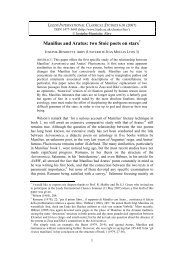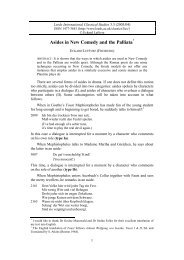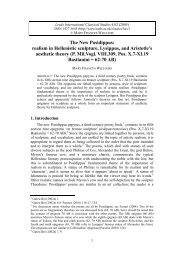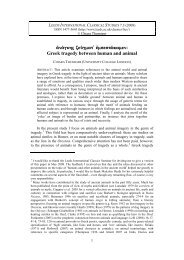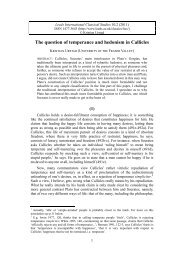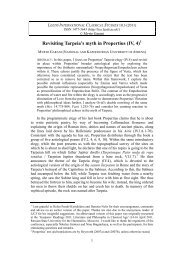Metalepsis, paragraphe and the scholia to Hermogenes - Leeds ...
Metalepsis, paragraphe and the scholia to Hermogenes - Leeds ...
Metalepsis, paragraphe and the scholia to Hermogenes - Leeds ...
You also want an ePaper? Increase the reach of your titles
YUMPU automatically turns print PDFs into web optimized ePapers that Google loves.
MALCOLM HEATH, METALEPSIS, PARAGRAPHE AND THE SCHOLIA TO HERMOGENES<br />
about conjecture? (He mentions only <strong>the</strong> legal issues <strong>and</strong> definition.) Strictly<br />
speaking, John argues (620.2-622.5), <strong>paragraphe</strong> cannot be conjectural; being<br />
documentary, <strong>the</strong> <strong>paragraphe</strong> itself must be legal. How, <strong>the</strong>n, can <strong>Hermogenes</strong><br />
envisage <strong>paragraphe</strong> based on definition? He does not mean that <strong>the</strong> issue is<br />
definition, but that <strong>the</strong> way <strong>the</strong> argument is developed may emphasise <strong>the</strong><br />
definitional aspect. As for <strong>paragraphe</strong> based on conjecture—which John himself<br />
has acknowledged—although, strictly speaking, <strong>the</strong>re is no such thing, <strong>the</strong>orists<br />
developed <strong>the</strong> concept for a special purpose. It may happen that a <strong>paragraphe</strong><br />
depends on a claim that is disputed in point of fact; <strong>the</strong>n <strong>the</strong>re is a conjectural<br />
question that has <strong>to</strong> be settled in order <strong>to</strong> determine <strong>the</strong> validity of <strong>the</strong> <strong>paragraphe</strong>.<br />
That is <strong>the</strong> situation with regard <strong>to</strong> Against Timarchus.<br />
John’s reference <strong>to</strong> Against Timarchus does not mean that he assumes that a<br />
<strong>paragraphe</strong> involves two hearings. He comments that a <strong>paragraphe</strong> is ‘often’<br />
introduced without <strong>the</strong> primary case, giving Against Timarchus as an illustration<br />
(625.12-14). This is not as strong as Sopater’s claim for <strong>the</strong> uniqueness of Against<br />
Timarchus, but it stills follows that <strong>the</strong> <strong>paragraphe</strong> is not always introduced<br />
separately, <strong>and</strong> nothing that John says rules out (for example) a single hearing in<br />
which a conjectural question has <strong>to</strong> be settled <strong>to</strong> resolve a dispute about <strong>the</strong> factual<br />
presuppositions of a <strong>paragraphe</strong>, before <strong>the</strong> parties proceed <strong>to</strong> fur<strong>the</strong>r legal<br />
argument about <strong>the</strong> <strong>paragraphe</strong> <strong>and</strong> <strong>the</strong>n <strong>to</strong> <strong>the</strong> primary case. Elsewhere he says<br />
that, once <strong>the</strong> question about <strong>the</strong> admissibility of <strong>the</strong> case has been argued out, <strong>the</strong><br />
speaker will proceed <strong>to</strong> address <strong>the</strong> primary case kat¦ perious…an—that is, as<br />
something not strictly necessary that makes a show of <strong>the</strong> abundant resources<br />
available <strong>to</strong> him (234.10-18). This way of thinking about <strong>the</strong> primary case implies<br />
that it is possible, but not necessary, <strong>to</strong> address both questions in one speech, <strong>and</strong><br />
that whe<strong>the</strong>r this is done is in some measure at <strong>the</strong> discretion of <strong>the</strong> speaker.<br />
John is one of <strong>the</strong> sources used by <strong>the</strong> commenta<strong>to</strong>r who goes by <strong>the</strong> name<br />
‘Sopater’ in <strong>the</strong> ‘three-man commentary’ of RG 4 (§3.4). This commenta<strong>to</strong>r also<br />
made use of <strong>the</strong> Sopater of RG 5. But <strong>the</strong> material taken from <strong>the</strong>se two sources<br />
was heavily, if inconsistently, adapted. Hence we must regard <strong>the</strong> commentary<br />
which goes under Sopater’s name in RG 4 as a substantially different work from<br />
that of <strong>the</strong> Sopater of RG 5. I offer a suggestion about <strong>the</strong> identity of <strong>the</strong> author in<br />
§3.5, but here for convenience refer <strong>to</strong> him as deutero-Sopater. 42<br />
Evidence that deutero-Sopater used more than one source, <strong>and</strong> was not always<br />
consistent in combining <strong>the</strong>m, is easy <strong>to</strong> come by. He incorporates Sopater’s<br />
criticism of <strong>Hermogenes</strong>’ claim that non-documentary metalepsis is about <strong>the</strong><br />
admissibility of <strong>the</strong> case. At <strong>the</strong> beginning it is adapted so as <strong>to</strong> report <strong>the</strong> criticism<br />
non-committally (mšmfontai ... tinej ... 276.21-277.8). This adaptation is almost<br />
unavoidable, since <strong>the</strong> contrary view has just been asserted (276.17-21), but it is<br />
not carried through consistently (289.7-24). Sopater’s criticism of <strong>Hermogenes</strong>’<br />
treatment of <strong>the</strong> prior question in <strong>the</strong> case of <strong>the</strong> man who consults <strong>the</strong> oracle is<br />
taken over (284.26-285.4), although it is also mentioned that <strong>Hermogenes</strong> has<br />
defenders on this point (285.9-17). The distinction between complete <strong>and</strong><br />
incomplete <strong>paragraphe</strong> (283.24-284.2) rubs shoulders with <strong>the</strong> contrast between<br />
42 The text of <strong>the</strong> ‘three-man commentary’ is given in Appendix 4.<br />
16



